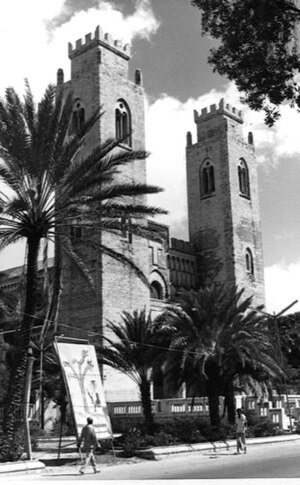Mogadiscio Cathedral
| Mogadishu Cathedral | |
|---|---|
 |
|
| Basic information | |
| Location | Mogadishu, Somalia |
| Geographic coordinates | 2°02′09″N 45°20′30″E / 2.035736°N 45.341614°ECoordinates: 2°02′09″N 45°20′30″E / 2.035736°N 45.341614°E |
| Affiliation | Roman Catholic |
| Country | Somalia |
| Year consecrated | 1928 |
| Ecclesiastical or organizational status | Cathedral |
| Architectural description | |
| Architectural style | Norman Gothic |
| Completed | 1928 |
The Mogadishu Cathedral is a Roman Catholic cathedral located in Mogadishu, Somalia. When still operational, it served as the seat of the Roman Catholic Diocese of Mogadiscio. In 2013, the Diocese announced plans to refurbish the building.
The Mogadishu Cathedral was built in 1928 by the Italian authorities in the former Italian Somaliland. Known as the Cattedrale di Mogadiscio, it was constructed in a Norman Gothic style, based on the Cefalù Cathedral in Cefalù, Sicily.
In 1989, on the eve of the outbreak of the civil war in Somalia, the last Bishop of Mogadishu, Salvatore Colombo, was killed by armed insurgents while giving mass in the cathedral.
In late 2008, much of the cathedral was destroyed by Islamic radicals.
A BBC correspondent later visited the site in 2012 and reported that some internally displaced people had formed tent settlements on the cathedral grounds. This was in stark contrast to the many new shops that had opened outside, where merchants, optimistic about the city's relative stability since the ouster of the insurgents, had begun to publicly advertise their wares again. The correspondent also mentioned that although the cathedral had structurally incurred considerable damage by having its roof blown off among other things, its walls were still erect, its elegant stone arches still in place, and the general atmosphere was one of serenity.
In April 2013, after a visit to the site to inspect its condition, the Diocese of Mogadiscio announced plans to rebuild the cathedral.
...
Wikipedia
